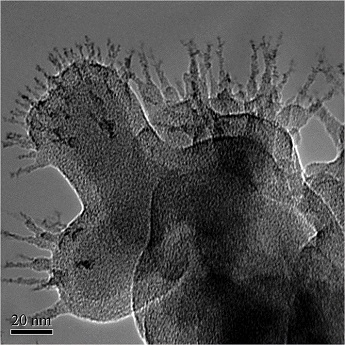
Caption:
Organic compounds in a CMP slurry showing the tail structures that aid in retaining the mechanical and abrasive properties of the metal oxide nanoparticles in the slurries.
Bushra B. Alam, MS, PhD Candidate
Advisor: Sara Brenner MD, MPH.
SUNY Polytechnic Institute Colleges of Nanoscale Science & Engineering
Nanobioscience Constellation
Albany, NY
Laboratory website: https://sunypoly.edu/research/team-brenner/
Technique: Organic materials in CMP slurry imaged by a JEOL 2010F Transmission Electron Microscope (TEM) operating at 200 kV.
Description:
During the production of the Complementary Metal Oxide Semiconductor (CMOS) wafer, the CMP process is used to planarize dielectric and metallic overlayers in several steps. While the metal oxide nanoparticles in the alumina, ceria and silica slurries are credited for their planarizing properties, additional organic materials are required to prevent agglomeration. This is a TEM image showing one of these structures which look like organic anemone under the TEM and elucidates the fascinating shapes of these materials at the nanoscale that aid in retaining the “perfect” slurry chemistry.
Funding Source: NanoHealth & Safety Center, New York State (awarded to P.I.)


